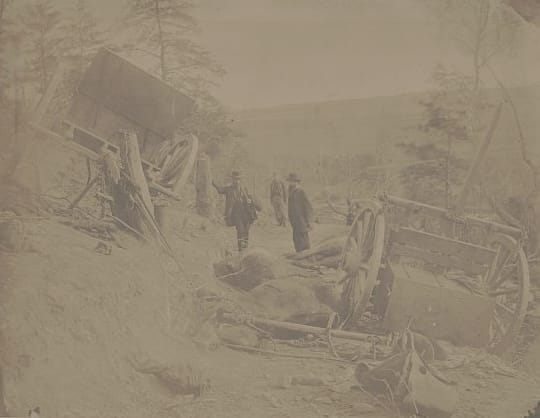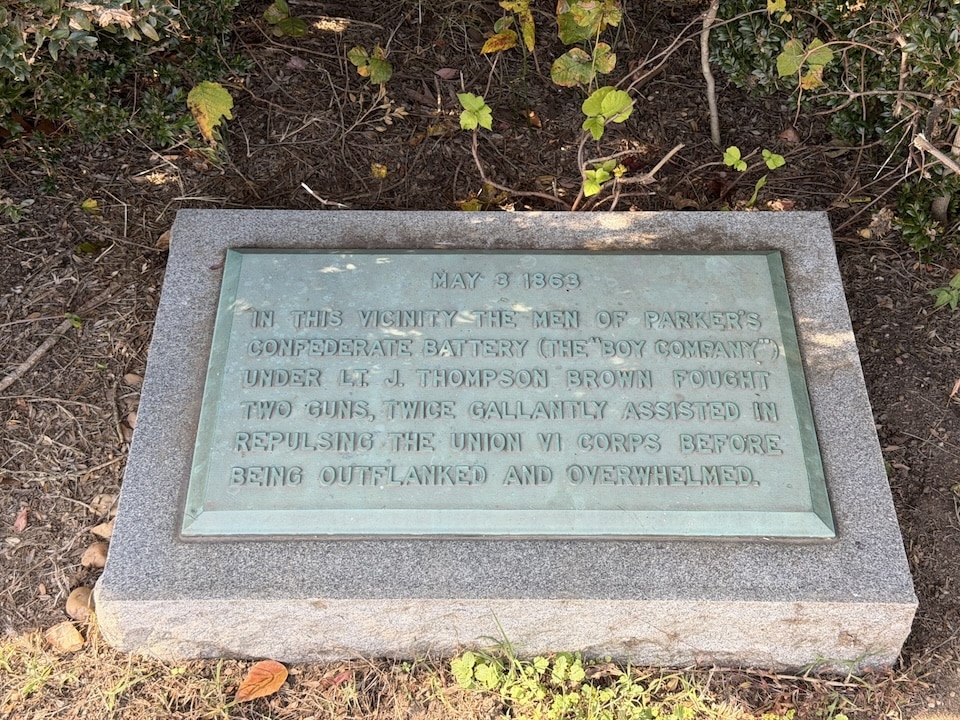“History Will Not Rob Them of Their Laurels”: Parker’s Battery During the Battle of Second Fredericksburg
Emerging Civil War is pleased to welcome Tyler McGraw of our social media team. Tyler had an ancestor who served with Parker’s Battery.
It was noon on the 29th of April 1863 when the boys of Parker’s Virginia Battery left their winter camp at Carmel Church in Caroline County, Virginia. They were ordered to do so in response to Union Gen. Joseph Hooker’s movement to Chancellorsville. Upon reaching the vicinity of Fredericksburg on April 30, the battery caught up with artillery chief Edward Porter Alexander. Seeing them, “my spirits rose with a delicious sense of the wicked power of which I was in control,” he remembered.
Parker’s Battery reached Tabernacle Church near the intersection of Mine and Plank Roads at roughly 10 a.m., and there they enjoyed a brief rest. They had covered more than 30 miles in twenty-two hours.
On the morning of May 1, while in reserve, Parker’s Battery was ordered to split in two. A portion remained in reserve, while the other traveled east back to Fredericksburg. Lieutenant J. Thompson Brown and roughly 40 members of the battery were sent to Marye’s Heights, to relieve Andrew B. Rhett’s South Carolina Battery, which had held a position there since December 1862. Throughout the winter, Rhett had constantly been absent from his position, so Brown took roughly 40 men and horses to take charge of two Parrot Rifles under Rhett’s command. By noon, Brown was in position atop a commanding ridge of hills collectively known as Marye’s Heights.
Army of Northern Virginia commander Robert E. Lee had ordered a small force under Jubal Early and William Barksdale to remain in Fredericksburg while he shifted the rest of the army toward Chancellorsville. This left only a small force of infantry and around 15 guns to safeguard the town. Marye’s Heights had been virtually impregnable during the December battle, but the force now trying to defend the heights would ultimately prove insufficient.
The morning of May 3 brought with it a dense fog. Once the fog lifted, the Confederates along the Sunken Road and atop the heights witnessed a heavy concentration of Federals within the town. Union batteries that had maneuvered into the western side of Fredericksburg during the night began “a vigorous fire of shell” against the Confederates.
Brown and the gunners from the Washington Artillery were ordered to reserve their ammunition until the infantry assaulted their positions. However, due to the incessant firing, Brown sought to take matters into his own hands. He dashed across the shell-pocked field and pleaded with Cap. C. W. Squires of the Washington Artillery to return fire against the Federal artillerists.
Squires declined to assist, sending Brown back to supervise his position on the field. Sergeant William Cogbill and Sgt. Edward “Sam” Duffey oversaw the two parrot rifles, the latter commanding a gun for the first time in the war. All around them, Federal shot began to take its toll. Brown had the horses sent to the reverse slope of the heights, which was so steep that the horses could not get out of range. The entrenchments surrounding the two guns did offer better protection, but even Brown suffered from the effects of a shell throwing dirt on his face. Brown cleaned himself up with the aid of a sponge bucket but appeared to be “suffering from smallpox” as a result.
The battery took part in repulsing the first wave of Federal attackers and two more futile assaults. Around 11 a.m. Col. Griffin of the 18th Mississippi accepted a flag of truce from two Federal officers who then realized just how thinly defended Marye’s Heights actually was. The Federal troops reorganized and rushed to the heights. When the Federals reached the stone wall just below the crest of the heights, it became nearly impossible for the Confederate artillery to defend the wall as they could not depress the muzzles of their guns enough to have any effect.
 Federals quickly overwhelmed the infantry along the Sunken Road, then set their sights on the heights. The next to fall was Capt. Squires’ guns of the Washington Artillery. Once Squires’ guns were captured, this left Brown and his boys from Parker’s Battery as the only serviceable guns on the field. Royall Figg who was a member of Parker’s Battery remembered:
Federals quickly overwhelmed the infantry along the Sunken Road, then set their sights on the heights. The next to fall was Capt. Squires’ guns of the Washington Artillery. Once Squires’ guns were captured, this left Brown and his boys from Parker’s Battery as the only serviceable guns on the field. Royall Figg who was a member of Parker’s Battery remembered:
In front we repulse them, as before; but behold! A rapidly advancing column on our left, sweeping down from the direction of the Marye house! “Hurrah, boys, here comes reinforcements!” “Reinforcements, the devil! They are Yankees!” says Cogbill.
The Yankees were the men of the 6th Maine. Cogbill’s men quickly moved the gun to repulse these incoming Federals. The Virginians loaded their gun with double canister, and Cogbill ordered them to fire when the 6th Maine was virtually abreast of them.
After the smoke from that shot cleared, both guns were in custody of the 6th Maine.
Sgt. Duffey knew it was hopeless to fight and waved a “meal sack” as a flag of surrender, to which he received fire until the attackers were within “10 steps” of him. Another member of the battery, Ed Martin, stayed to surrender but was killed in the attempt. The remaining members of Brown’s detachment were captured and sent to Fort Delaware.
Meanwhile, Capt. William Watts Parker was engaged at Chancellorsville on May 3 with the other half of his battery and was not aware of the situation with Brown’s detachment. In a letter written about Chancellorsville, Parker wrote:
It seems from all that can be learned that the two pieces at Marye’s Hill were unavoidably captured by the falling back of the infantry. Before any notice was given, the position was flanked on the right, and no opportunity was offered the battery to fire a shot. When the enemy was first seen, they were in large force, just in the rear of the battery, coming up at double-quick, and I presume every man was taken prisoner. They had nothing but empty hands to oppose thousands of muskets and bayonets, and I presume, in so helpless a condition, none were killed by the enemy.
The site of this engagement is within the Fredericksburg National Cemetery. A small plaque to Parker’s Battery commemorates the area where Brown’s detachment fought.
SOURCES:
Parker’s Virginia Battery C.S.A., by Robert K. Krick. (Broadfoot Publishing Company) 1989.
Where Men Only Dare To Go, Or The Story Of A Boy Company, C.S.A, Royall Figg (Whittet & Shepperson) 1885.
Edward S Duffey Diary – VMHC


